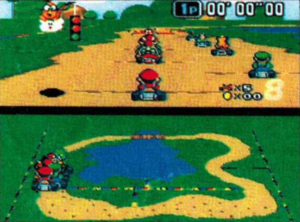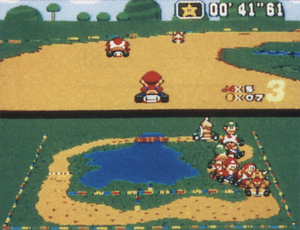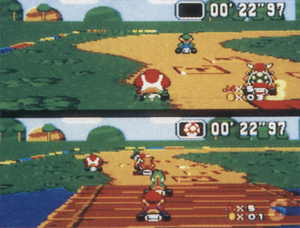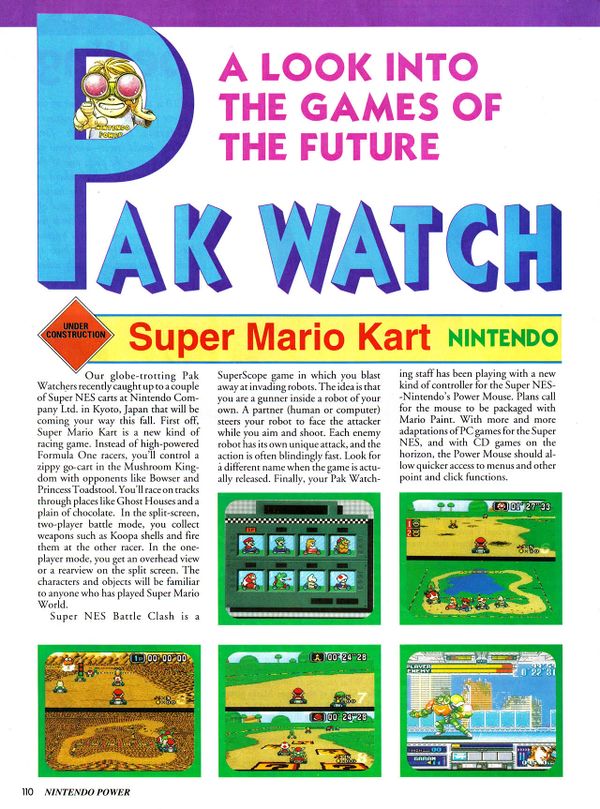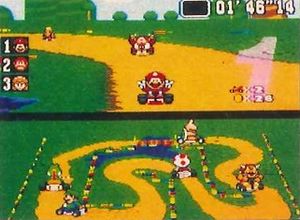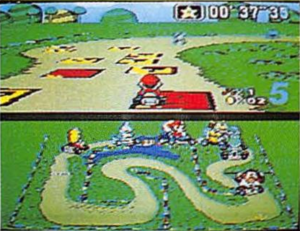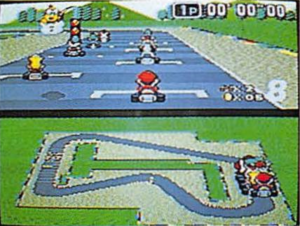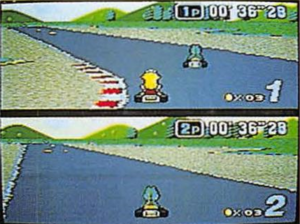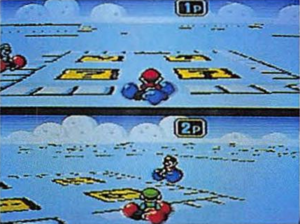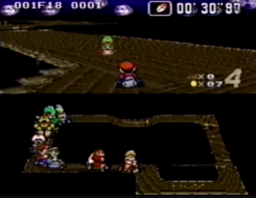Prerelease:Super Mario Kart
This page details pre-release information and/or media for Super Mario Kart.
To do:
|
Development Timeline
After the success of F-Zero, Nintendo wanted another racing game but with the ability to play with two players at the same time. When development began, the team realized very early on that due to the SNES' technical limitations very large maps like in F-Zero wouldn't be possible since the maps have to be rendered twice for both players. The first ideas included car races with more focus on zipping and turning on tracks with many twists rather than full-speed races.
In a 1992 developer interview, Shigeru Miyamoto, the game's producer, mentioned the idea of "a fun, lighthearted game where you zip around unrealistically in cars. It wouldn’t be the life-or-death, dangerous world of F1 racing, but more the atmosphere of screeching wheels as you zip around an amusement park. From those ideas, the concept eventually evolved naturally from cars to karts." In early alpha versions of the game, there were only generic guys with big helmets in cars and also hovercrafts. The idea to put Mario in a kart to race came later.
1990
- Fall - Early experiments are done.
1991
- April - Initial development begins.
- April-July - Early tracks and alpha versions are created that include, besides Kart racing (named "CAR" in the alpha), the idea of hovercraft machines.
- November - A prototype is created that includes many early ideas and experiments with various tracks, objects, 3D-like decorations, and many early ideas for Battle Mode such as Coin Collection and "Machine-Gun" modes, as referenced in this developer interview.
1992
- February 13 - Another early prototype is created. Several other Battle Mode ideas such as a "Gate" battle were experimented with around this time, but were cut due to memory limitations according to Hideki Konno, one of the game's directors.
- April 13 - Another prototype is built. Some tracks and graphics are almost done but still have many differences. Gameplay is different, such as drifting. Many tracks still look pretty different compared to the final game.
- April 14 - The layout for Choco Island 3 was updated for the last time.
- April 21-30 - B-roll footage for Summer CES was recorded within this timeframe.
- May 8-14 - Rainbow Road, the game's final track, is created and replaces Choco Island 3.
- May 18 - Another prototype is created. Some tracks are almost finalized and the final drifting style is implemented.
- Late May - The undumped prototype was built around this time.
- May 28-31 - The game makes an appearance at the Summer CES in Chicago, with a playable build at the show floor.
- May 28 - The file END-MOJI.CGX.BAK was created, indicating the credits were being implemented around this time.
- June - 150cc and end credits are added.
- Late June - Rainbow Road's BGM was completed, making it the last song to be added.
- August 27 - Super Mario Kart is released in Japan.
- September 1 - Super Mario Kart is released in North America.
- November 21 - Super Mario Kart is released in Europe.
Images
Early Spring '92
Donut Plains 1
A select assortment of early screenshots appeared in various publications around the time of the game's release. A few of them show an early version of Donut Plains 1 with a different layout. This layout appears in the April 13, 1992 prototype.
- The road at the bottom continues straight rather than bending upwards, and there are many Monty Moles on the bottom road.
- The lake is much larger.
- The bridge is slightly broken and there is no wall that encloses it.
- The inner wall only encloses the bottom part of the track under the lake and contains an extra mushroom shortcut on the bottom road.
The screenshots shown appear to be from 2 different builds.
- In the first screenshot, the starting positions for all characters is the same as the Nov 91 and Feb 92 prototype builds, and the ? panels in Donut Plains 1 are in front of the finish line; however, in the later build in the other two screenshots, they are placed before and after the bridge, though they would be placed in front of the finish line again for the final release.
- The player starts out with a max of 5 karts, which is not possible to have in the final. This also means there was no extra lives given out at this point in development.
- The player starts out with 0 coins.
Bowser's Castle 3
| Early '92 | April 13 Proto |
|---|---|
 |
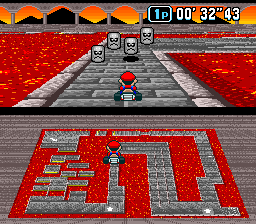 |
| Mock-Up | April 13 Proto |
|---|---|
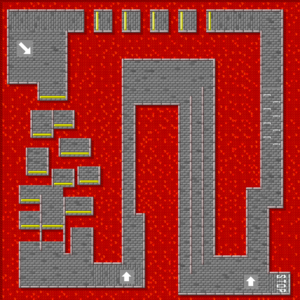 |
 |
An early version of Bowser Castle 3 that features multiple platforms at the upper side of the track with three of them removed in the final, and the small straight away before the platforms was extended later on. There is also an extra platform on the left as well as a STOP in the bottom-right, both also being removed later on. This track predates the April 13, 1992 prototype, so these screenshots are possibly from an even earlier, unknown build, presumably from in the first quarter of '92. The platforms at the top can be seen in the Oct 1991 map.
Battle Mode

The timer from the other modes was present at one point, but was removed from Battle Mode as it served no purpose.
Match Race
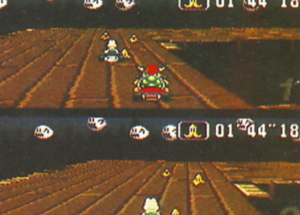
The coin counter is missing in this build. The track in the screenshot is likely Ghost Valley 3.
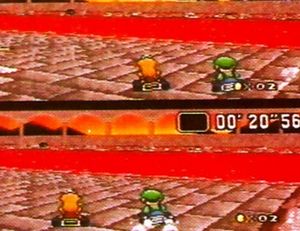
A screenshot from a later build with the coin counter added. Notably, Luigi's seat is colored blue here, meaning he didn't use the lower half of Mario's graphics yet. The track shown is likely Bowser's Castle 2.
Nintendo Power Issue
Issue 38 of Nintendo Power shows two more shots of the early Donut Plains 1 track as well as an early character select screen, which appears to have a different order than the final, and an early Choco Island 1, which is missing the puddles on the bottom portion of the track.
These screenshots appear to be from the April 13, 1992 prototype.
Summer CES' 92
Super Mario Kart made an appearance at the Summer Consumer Electronics Show (CES), which was held in the end of May. While the game itself looks mostly complete, It still has a number of small changes.
Title Screen
| Summer CES | Final (Japan) |
|---|---|
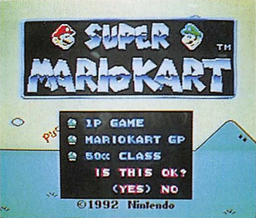 |
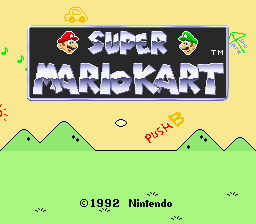 |
Despite the build being in English, the logo is based off the Japanese version. The only subtle difference is that Mario's mouth is closed.
Results Screen
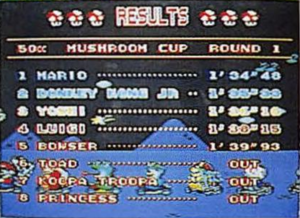
Opponents who didn't make it past the finish line before the results screen appears after the race are labeled as "OUT". In the final, they are given a time regardless.
Choco Island Battle Course
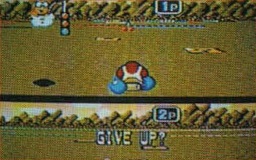

A Choco Island themed battle course not present in the retail game. It was scrapped in favor of the final game's Battle Course 1. This early map is present in the earlier April 13, and May 18 prototype builds.
Video
Several brief glimpses of Super Mario Kart at CES can be seen at the following timestamps:
- 0:20 - 0:28 - B-roll gameplay footage of an earlier build from the playable one seen at the event can be seen on the stage screen. the footage was likely recorded between April 21 - April 30, based on the modification dates of several .BAK files for Donut Plains 1 and Choco Island 1's layout files. The following differences as well as changes from the April 13 build can be seen here.
- The small screen captures surrounding the main video appear to be from earlier on in the video, which shows Donut Plains 1's early layout.
- The bumps on the top road of Choco Island 1 are now added and the bumps no longer throw the player involuntarily like they did in the April 13 build, though the bottom of the road is still missing the puddles and the track appears to share the same overlay placement.
- Going over a bump makes the same noise as going over the holes in Donut Plains. This change is also present in the later May 18 build.
- Choco Island's BGM is now added. In the April 13 build, it shares the music for Koopa Beach.
- Coin SFX is now final.
- 2:03 - 2:10 - The playable prototype at the booth showing a Match Race on Mario Circuit 1. Notably the booth uses an entirely different logo than the one used in-game.
- The overlay placement for Mario Circuit 1 is the same as the May 18 build, which is missing two extra ? panels that were later added.
- The spin-out animation for getting hit by a shell is now final, adding the overshoot at the end. In earlier builds, the animation ended more abruptly.
Assorted Screenshots
Other Notable Differences
- The item slot displays as 1P and 2P instead of 1 and 2 like in the final.
- The player starts out with only 2 lives instead of 3.
- Donut Plains 1 had a more jagged wall structure and the ? panels are in a different position.
Japanese Promotional Video
| April Proto |  | |
The drift explanation |
|---|---|
| Final | 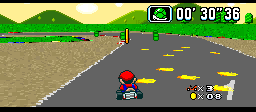
...and not the final version. |
One of the debug tools, the Mini RAM Viewer / Editor, can be seen briefly at 6:15 in this promotional video.
Additionally, the drift control is explained differently, matching the drift mechanics from the April prototype and earlier versions and not the final version, although funnily enough it is shown in the video using the final version, which doesn't work.
Among other things the promo video says that ending a drift is done by counter-steering rather than doing a jump. This not only doesn't really work but also at 8:11 in the video, the player doesn't do it that way anyway and does it correctly by doing a jump.
This is actually how ending a drift in the April prototype works.
